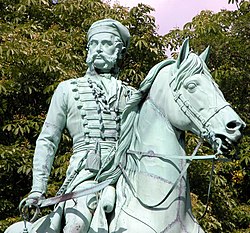88.106.195.58 (talk) |
|||
| Line 23: | Line 23: | ||
==Notes== |
==Notes== |
||
{{reflist}} |
{{reflist}} |
||
[[de:Schwarze Schar]] |
|||
[[Category:Military history of Germany]] |
[[Category:Military history of Germany]] |
||
Revision as of 13:22, 11 May 2007

The Black Brunswickers were a group of foot and cavalry infantry who served under German-born Frederick William (1771-1815), and who were formed in 1809 after the war broke out between the French and the Austrians.[1][2][3] The men who made up the regiment were volunteers, and were dressed in black broadcloth, with a silvered badge on their hats showing a death's head. They dressed in this macabre way to mourn the death of their commander, Frederick William. It is known that the Duke was one of the most bitter disapprovers of Napoleon's occupation of Germany.[1]
Life of the Brunswickers
The war between the French and the Austrians broke out in 1809, and this prompted William to create, with the support of the Austrians, an armed force. The force was made up of 2300 hussars and the Black Brunswickers (or the 'Black Horde' as they were colloquially known)[1] were born.[4] William financed the corps independently by mortgaging his principality in Oels.[4] In 1809, Frederick William and his legion of Brunswickers were momentarily able to take control of Brunswick, thus its name.[4] After this victory, however, the Duke fled to the United Kingdom to join with his brother-in-law (a man who would later become King George IV). The forces of the Brunswickers were largely destroyed in battles and skirmishes fought in Spain and Portugal.[4]

Quatre Bras
After the Duke returned to Brunswick in 1813, he gathered new troops into the devastated ranks of the Brunswickers.[4] Despite these new recruits, the regiment underwent great difficulty at the battle of Quatre Bras at Waterloo in 1815. They suffered many losses,[2] including the death of their commander and leader, the Duke Frederick William. On 16 June, he was killed by a misguided gunshot.[3][4]
Inspired art
'The Black Brunswicker' (1860), by John Everett Millais was inspired in part by the exploits of the Brunswickers[2] and in part by the contrasts of black broadcloth and pearl-white satin in a moment of tender conflict.
In a letter to Effie Gray, Millais described his inspiration for the work:
My subject appears to me, too, most fortunate, and Russell (the war correspondent of Times) thinks it first-rate… I have it all in my mind's eye and feel confident that it will be a prodigious success. The costume and incident are so powerful that I am astonished it has never been touched upon before. Russell was quite struck with it, and he is the best man for knowing the public taste. Nothing could be kinder than his interest, and he is to set about getting all the information that is required.
[2]
Millais reduced the presence of Napoleon to an engraving after David's Napoleon Crossing the Alps, which is framed on the damask-hung wall, which "perplexed the critics with the possible intricacies of cross purposes and rival jealousies" according to the reviewer from Blackwood's Edinburgh Magazine.[5] The artwork took an estimated three months to paint, and it was greatly admired at the time. It was also bought for the highest price Millais had ever received from dealer and publisher Ernest Gambart - the lucrative sum of 100 guineas.[2] Later, in 1898, William Hesketh Lever purchased the work for his private collection.[2] Charles Dickens' daughter was used as a model for the woman seen in the picture.[2]
Notes
- ^ a b c "Osprey Publishing".
{{cite web}}: Unknown parameter|accessmonthday=ignored (help); Unknown parameter|accessyear=ignored (|access-date=suggested) (help) - ^ a b c d e f g "Lady Lever Art Gallery - artwork of the month".
{{cite web}}: Unknown parameter|accessmonthday=ignored (help); Unknown parameter|accessyear=ignored (|access-date=suggested) (help) - ^ a b "Infoplease.com".
{{cite web}}: Unknown parameter|accessmonthday=ignored (help); Unknown parameter|accessyear=ignored (|access-date=suggested) (help) - ^ a b c d e f "Wikipedia article on Frederick William".
{{cite web}}: Unknown parameter|accessmonthday=ignored (help); Unknown parameter|accessyear=ignored (|access-date=suggested) (help) - ^ The Royal Academy and Other Exhibitions Blackwood's Edinburgh Magazine 88.537 (July 1860).